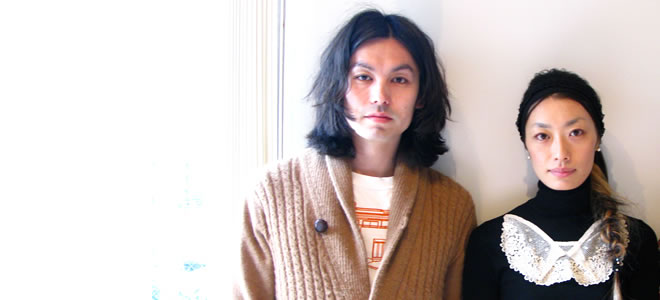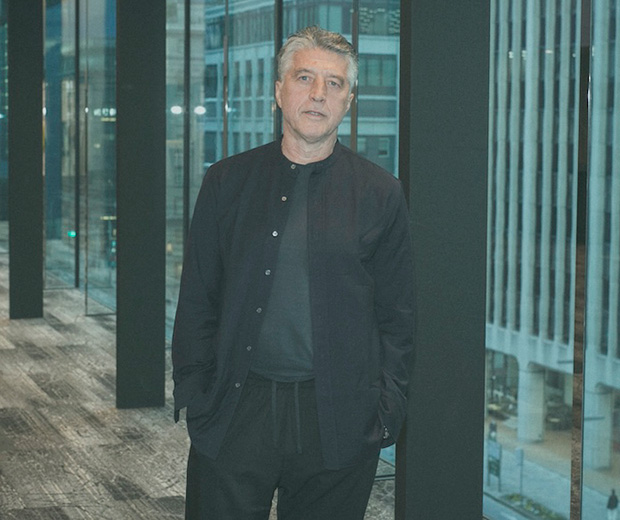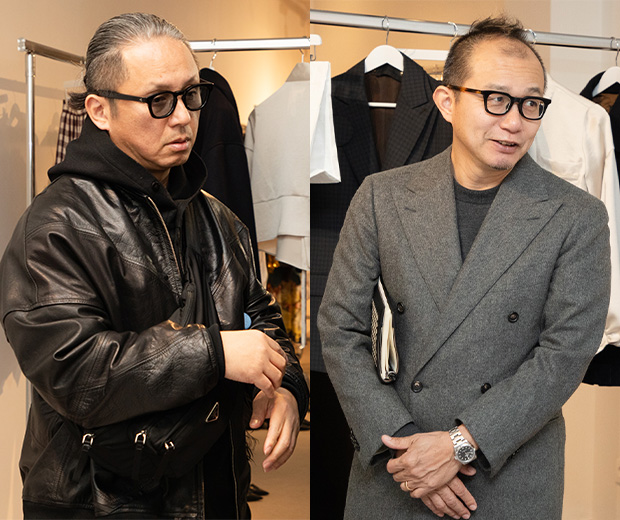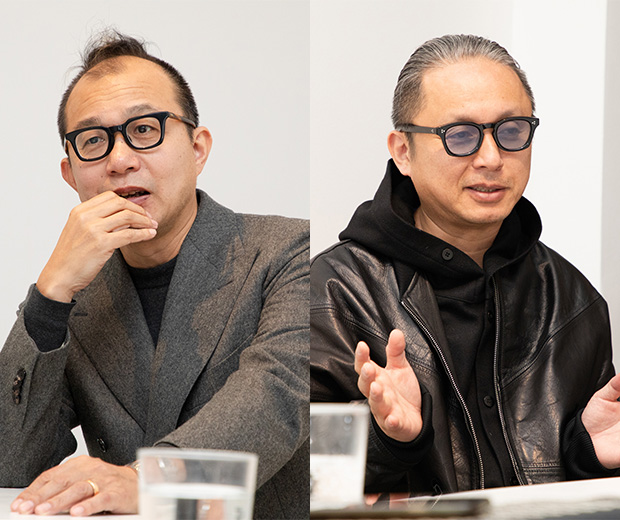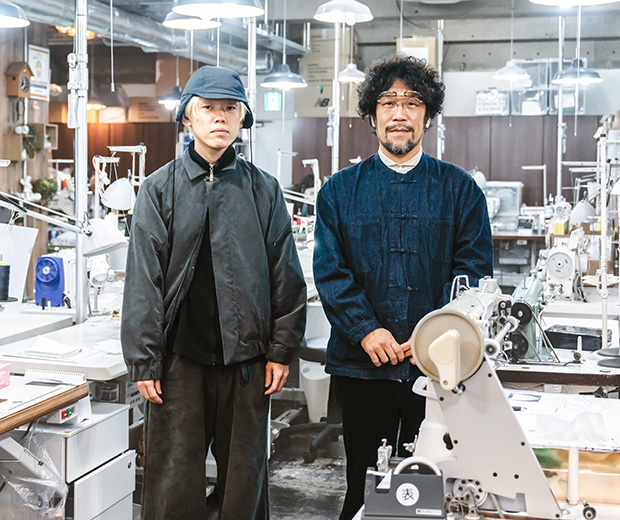AKIRA TAKEUCHI / TAYUKA NAKANISHI
Theatre Products is a brand with a unique world view that seriously pursues creations that are unmatched by any other brand without being affected solely by trends and novelty, with its concept of “with clothing, the world becomes a theatre.” They will be celebrating the tenth anniversary of the brand next year.
We asked the designers, Akira Takeuchi and Tayuka Nakanishi about the origins of their clothes-making that has struck a chord with numerous fans primarily in Tokyo.

The theme of your latest collection is “CAMOUFLAGE.” I heard that the work of the artist Edouard Vuillard, who was popular at the beginning of the 20th century, was the source of inspiration?
Nakanishi:I always like Edouard Vuillard’s paintings. When I took a new look at Vuillard’s paintings, I thought that this was the world that we wanted to express, and thought that we would be able to express the paintings with a sense of fullness. Apparently, Vuillard frequently used scenes from daily life and scenes with people as material for his art. He uses various colors and detailed patterns, and I thought that was interesting. That led to our theme of camouflage.
Takeuchi:Space forms when a person enters it; people exist within spaces. When I thought about how to express this, camouflage was the word that fit best.
Were you conscious of the time period in which Vuillard lived?
Nakanishi:We didn’t consider that too much in our work. One of our keywords in the process of making our collection was “languor,” and we expressed this through silhouettes, fullness, and use of color, but this may have just happened to match the mood of the time.
Do you divide work among yourselves in the design process?
Takeuchi:No, we don’t divide the roles. It depends on the time and may differ depending on the collection.
Nakanishi:We each throw out some ideas, and then stick them together. So if one of us proposes something that the other person doesn’t care, it may be completely ignored. However, this process is what is important, and by throwing out your vague ideas to the other person and receiving feedback, we are able to obtain a sense of directionality. We believe that our clothes are only complete when a person wears them, so we make the clothes while imagining what a person will do while wearing the clothes, and where he or she will go, etc. However, if we are caught up in daily life all the time, our vision becomes too narrow. I feel like the dialogue that we have in the process of making clothes enables us to create clothes that can be worn while still having a strong message.

I heard that you are going to record the pattern of the runway with a 3D camera and create a video product?
Nakanishi:I’ve always been interested in 3D, but I thought that it was particularly suitable to express our current theme. The recording will be done with help from Panasonic. It is not yet complete, but we are looking forward to what the completed video will look like.
Takeuchi:It shows our persistence by using 3D image, in terms of enjoying the 3D. The video can be seen from December 10 to 27 at the “PASS THE BATON GALLERY” of Omotesando Hills. All the fixtures, such as the ladder used in the show, belong to “PASS THE BATON”, so the set that was actually used in the show can be exhibited and purchased. The completed video product is scheduled to be announced next year.

Every season, an elaborate production draws our attention; for Theatre Products, what does the runway signify?
Takeuchi:We are actually not that particular about fashion shows. However, the shows are simply the most effective and easy way to let people as many people as possible know the world view that we want to express, the clothes, and how these clothes look when worn.
In addition to fashion shows, you also frequently collaborate with other brands and manufacturers. What triggers you to start these collaborations?
Takeuchi:This season, we are working with Kyoritsu-Toki, a pottery manufacturer in Nagasaki. The collaboration just happened naturally. Kyoritsu was introduced to us by the fabric store that we do business with.
Nakanishi:Every season, they make fabric for us that strongly reflect our theme. One day, they called us and asked, “Are you interested in pottery?” and we immediately replied, “Yes!”
Takeuchi:Hasami pottery was very accessible to me since I am from Nagasaki, and I found out later that the manufacturer was actually located near where I grew up. When I went to visit them, they were really close by and I found out that we had common acquaintances, and they knew my father.
I would like to find out about the origins of Theatre Products. When did you two start to become interested in fashion?
Nakanishi:I’ve wanted to make clothes ever since I can remember. My mother’s hobby was dress-making, so perhaps making clothes felt familiar. I never made my own clothes on a daily basis, but I loved to draw. When I was small, I often drew pictures of girls, but for me, what the girls were wearing was very important. Come to think of it, that may be the start of my interest in fashion. I seemed to subconsciously know that clothes could be bought or made.
Takeuchi:When I think back, it was probably when I was in 7th grade. The theatrical performance that I saw at the school cultural festival gave me a big impact, and I knew that I definitely wanted to do something like that one day. Although the rendering is different, I think it is the same in that I make an image into a shape and transmit it. I think my interest in clothes started when I participated in a one-day draping lesson that I took at a seminar hosted by the school, and had a lot of fun.
Nakanishi:I’m from Isehara City in Kanagawa. Now, I like vintage objects, but in the past, it didn’t even occur to me to look for them. Tokyo isn’t far, but it isn’t exactly close either(laughs). I think the first time that I went to a sale in Harajuku was when I was in my first year of high school.

What kind of place is the Tokyo of today for the two of you?
Takeuchi:A city that accepts fashion in a straightforward manner. As a fashion manufacturer, I think it is a very blessed environment.
Nakanishi:Many things in Tokyo are affected by things from foreign countries. I think that this Western culture unique to Japan is subconsciously reflected in manufacturing, and I am very aware of this fact.
Is there anything that you are currently into, or are taking notice of?
Takeuchi:I’m into Nasu Town. Kao Kanamori became the organizing committee chairperson starting last year, and they are organizing an event called “Spectacle in the Farm”, and it is due to be held on November 27 and 28 this year. This year, they are collaborating with Nasu University, and various people will perform live concerts and performances using the school buildings, gymnasium, and schoolyard of the university. The event will be bigger this year than last year, so I encourage you to visit.
Nakanishi:I’m into “PASS THE BATON.” I go there on my own time, and even when I go there supposedly for work, before I know it, I feel like I’m there for fun. It’s close to my atelier, so I go there frequently. In terms of creators, the musician Shota Hasunuma, who helped us on the music for this collection, was also a wonderful encounter.

